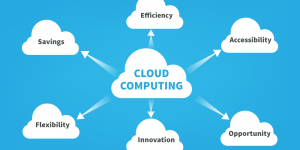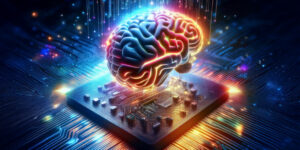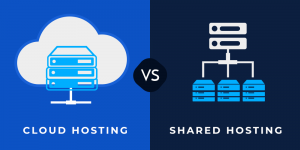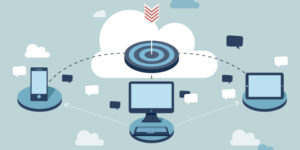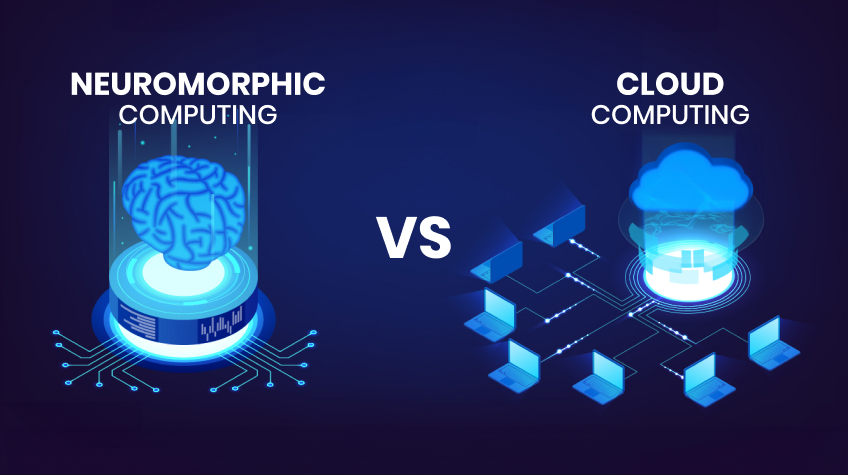
Neuromorphic Computing and Cloud Computing are two distinct paradigms in the field of modern computing. Each of them provides unique capabilities in handling data, processing information, and driving innovations. While they have some similarities, they operate on fundamentally different principles and are suited for different use cases. In this article, we will have a look at some differences between neuromorphic computing vs cloud computing by highlighting their, advantages, and disadvantages.
What is Neuromorphic Computing?
The computing form is inspired by the human brain’s structure and function, and it attempts to replicate the brain’s neural networks in silicone hardware to endow systems with capabilities like learning, reasoning, and adaptation. Neural networks constitute the core of neuromorphic computing, with networks designed to simulate the working neurons in the transmission of signals and experience-based learning.
It takes a specific piece of hardware, such as neuromorphic chips, that uses artificial neurons and synapses to process information in parallel with human brains. These chips are optimized for tasks related to high levels of recognizing certain patterns, sensory processing in real-time, and possibly decision-making. Neuromorphic computing has great scope in robotics, Artificial Intelligence/Machine Learning and cognitive computing among others.
What is Cloud Computing?
Cloud computing is a model in which computing resources and services are delivered through the Internet. Businesses and individuals can access and use powerful computing infrastructure, such as storage, processing power, and software applications, without needing physical hardware on-site.
Cloud computing operates based on a pay-as-you-go approach, meaning users pay for only the resources used and thus is cost-effective and scalable.
Large-scale data centers by such tech giants as Amazon Web Services (AWS), Microsoft Azure, and Google Cloud generally offer cloud computing. Its uses range from hosting websites to the running of machine learning models and big data processing. Cloud computing offers easy collaboration, remote access, and a variety of technologies integration on one platform.
Difference Between Neuromorphic and Cloud Computing
1. Architectural Foundations
- Neuromorphic Computing draws inspiration from human brains, leveraging hardware that emulates neutral processes, often in the form of neuromorphic chips or specialized processors. This is centered on efficient parallel processing and real-time learning.
- Cloud Computing is based on the centralized data centers that deliver resources over the Internet. It follows a distributed architecture, with pooled computational resources available from a remote location.
2. Processing Approach
- Neuromorphic Computing processes information in an event-driven and asynchronous manner, similar to how the brain works. It is particularly well suited for tasks such as pattern recognition, sensory processing, and decision-making.
- Cloud Computing is better suited for applications like data storage, hosting web servers, and applications. It typically runs under a request-response model wherein users query servers and then wait for the responses
3. Use Cases
- Neuromorphic Computing is immensely well-suited for AI, ML, robotics, and cognitive computing applications, as its ability to simulate the human brain’s learning and adaptability gives it an advantage in environments that require real-time decision-making, pattern recognition, and sensory input processing.
- Cloud Computing is used for applications that require amounts of computational power storage, such as data analysis, cloud-based computing, web hosting, and enterprise resources planning (ERP). It is also used for scale AL and ML models that require significant processing power.
4. Resource Management
- Neuromorphic Computing is resource-efficient because it processes information asynchronously and only when needed, which is similar to the energy-efficient nature of biological brains.
- Cloud Computing is very scalable and flexible but also a resource-hungry solution. One has to pay for every computing power and storage, which may lead to a relatively higher cost of operation with resource-heavy tasks.
5. Energy Consumption
- Neuromorphic Computing aims to be highly energy-friendly, similar to the brain performing complex tasks with minimal use of energy. It best fits low-power devices including edge computing systems and Internet of Things devices.
- Cloud Computing is powerful but consumes enormous amounts of energy because it operates in large-scale data centers that maintain continuous cooling and power systems
6. Real-Time Performance
- Neuromorphic Computing is very powerful in real-time performance regarding sensing input analysis, dynamic learning, and real-world interaction since it processes data in the hardware itself without depending on some external systems.
- Cloud Computing mostly suffers from latency issues related to processing real-time data, given its dependency on internet connectivity as well as remote servers, which results in its less effective usage of time-sensitive applications.
7. Hardware and Infrastructure Requirements
- Neuromorphic Computing relies on special hardware such as neuromorphic chips, which will be costly and still developed for large-scale usage.
- Cloud Computing relies on standardized server hardware that has already been developed and is available everywhere, hence offering better accessibility and also easier to deploy.
8. Scalability
- Neuromorphic Computing is applied where its specific architecture benefits some specialized task, and by the available hardware, the scalability is limited.
- Cloud Computing is known for its massive scalability. Resources can be added or removed dynamically to meet demand, making it ideal for both small businesses and large enterprises that need to scale quickly.
Also Read: Different Types of Computing
Advantages and Disadvantages of Neuromorphic and Cloud Computing
1. Neuromorphic Computing:
| Advantages | Disadvantages |
|---|---|
| Extremely efficient for real-time decision-making, sensory processing, and learning. | Still in its initial stage of development and, for the most part, unavailable hardware. |
| Energy-efficient and faster for certain specialized applications. | Implementation calls for specific knowledge and infrastructure to be effective. |
| Capable of adaptive learning and pattern recognition similar to the human brain. | Still too limited for general use as a computer. |
2. Cloud Computing:
| Advantages | Disadvantages |
|---|---|
| Resources are scalable to be flexible for numerous applications and industries. | Dependent on internet connectivity. Can sometimes experience latency and downtime. |
| Easily accessible from any remote area, which means easy access to remote work and teamwork. | Resource-intensive applications will be costly. |
| It provides high-performance computing and huge amounts of storage for massive-scale applications and handling big data. | Security, and privacy issues when sensitive information is stored in remote locations. |
Which is Better: Neuromorphic Computing or Cloud Computing?
The choice between neuromorphic computing and cloud computing depends on the application and its specific needs. Neuromorphic computing is best suited for tasks that require real-time processing, low latency, and energy efficiency. It is particularly suitable for applications such as robotics, autonomous systems, and sensory input processing, where adaptive learning and rapid decision-making are necessary.
Cloud computing, on the other hand, shines in scenarios requiring scalability, flexibility, and the ability to handle massive workloads. It is particularly effective for big data analytics and machine learning model training, where centralized resources and distributed computing infrastructure provide unmatched power.
Ultimately, the choice between the two paradigms depends upon the specific use case: neuromorphic computing can be better suited for dedicated, adaptive, and hard real-time tasks, but cloud computing is best suited to scalable, general-purpose computation and enterprise-level operations.
Also Read: Fog Computing vs Cloud Computing vs Edge Computing
Conclusion
Neuromorphic computing and cloud computing are two very different paradigms in the technological world. While neuromorphic computing is inspired by the brain and excels at learning, decision-making, and real-time processing tasks, cloud computing provides on-demand access to vast computational resources and storage, making it more suitable for general-purpose applications and scalable enterprise needs.

